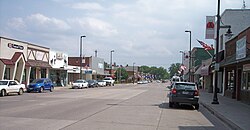2010 Census
As of the census [11] of 2010, there were 3,571 people, 1,513 households, and 857 families living in the city. The population density was 714.2 inhabitants per square mile (275.8/km2). There were 1,684 housing units at an average density of 336.8 per square mile (130.0/km2). The racial makeup of the city was 98.4% White, 0.2% African American, 0.3% Native American 0.3% from other races, and 0.9% from two or more races. Hispanic or Latino of any race were 2.2% of the population.
There were 1,513 households, of which 28.1% had children under the age of 18 living with them, 37.6% were married couples living together, 13.4% had a female householder with no husband present, 5.6% had a male householder with no wife present, and 43.4% were non-families. 37.8% of all households were made up of individuals, and 20.3% had someone living alone who was 65 years of age or older. The average household size was 2.21 and the average family size was 2.87.
The median age in the city was 39.6 years. 23.4% of residents were under the age of 18; 8.4% were between the ages of 18 and 24; 23% were from 25 to 44; 23.3% were from 45 to 64; and 21.8% were 65 years of age or older. The gender makeup of the city was 47.2% male and 52.8% female.
2000 Census
As of the census [3] of 2000, there were 3,139 people, 1,381 households, and 814 families living in the city. The population density in the year 2000 was 781.2 per square mile (301.4/km2). There were 1,471 housing units at an average density of 359.9 per square mile (139.0/km2). The racial makeup of the city was 96.71% White, 0.28% African American, 1.28% Native American, 0.19% Asian, 0.03% Pacific Islander, 0.25% from other races, and 1.25% from two or more races. 1.57% of the population were Hispanic or Latino of any race.
There were 1,381 households, out of which 29.2% had children under the age of 18 living with them, 43.2% were married couples living together, 11.8% had a female householder with no husband present, and 41.0% were non-families. 36.9% of all households were made up of individuals, and 21.2% had someone living alone who was 65 years of age or older. The average household size was 2.23 and the average family size was 2.89.
In the city, the population was spread out, with 24.3% under the age of 18, 8.2% from 18 to 24, 24.3% from 25 to 44, 19.9% from 45 to 64, and 23.3% who were 65 years of age or older. The median age was 40 years. For every 100 females, there were 84.6 males. For every 100 females age 18 and over, there were 80.7 males.
The median income for a household in the city was $30,566, and the median income for a family was $40,577. Males had a median income of $32,222 versus $21,797 for females. The per capita income for the city was $17,949. 9.0% of the population and 6.0% of families were below the poverty line. Out of the total population, 7.7% of those under the age of 18 and 10.1% of those 65 and older were living below the poverty line.




